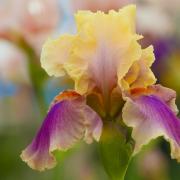Bulbs are little energy powerhouses, lying dormant below ground and then bursting forth in an array of colours and forms. And nothing can beat bulbs for maximum colour impact in spring. Daffodils are the best known, most adaptable and at their peak now.

Bulbs can create vibrant vignettes in the garden or containers with very little effort. Combine a mix of bulbs together or intermingle them with annuals, perennials, shrubs and trees that feature in spring, the possibilities are vast. Flowering bulbs are very adaptable and give attractive effects. Some work well naturalised, such as narcissi, anemones and fritillaries, others such as tulips, need to be lifted and replaced each year. All can be used in large or small gardens as well as pots and containers. Clumps work well for impact: bulbs can be popped in among plants as bright accents, a container can be all the same bulb en masse, or you could use a dainty mix of tiny varieties. The only limitation is your creativity and imagination.

Are you aiming to lighten a dull corner with pale cream and white narcissi, be bold and bright on the patio, create a natural look with drifts or harmonise the tones for a pretty effect? You may be after a succession of blooms with bulbs popping up at different times, creating a new look as one finishes. Keep in mind that the bulbs suit your conditions. Some do well under deciduous trees in part light, such as snowdrops, muscari and scilla, others like full sun, including irises and alliums. As bulbs get most of the sunlight, they need to appear before trees are in leaf, but they can be planted almost anywhere in the garden. In general, bulbs need a well-drained, sandy loam soil, which is not overly rich. You can improve heavy soils by adding sand and well-rotted organic matter to make them more friable. Remember after flowering to allow the leaves to die back naturally as they need the energy from the foliage to the bulb to produce next year’s flowers. Plan to have foliage from accompanying plants cover the bulbs as they die back.

Many bulbs grow to perfection in tubs, troughs and pots and you have the added advantage that you can move them into prominence when ready to flower, whether tucked into garden beds in their containers or grouped for displays, and then removed when at the dying back stage. Once finished, plant out into the garden for next year. Layering or lasagne planting is very popular so there are bulbs popping up to flower at different times. This works well with snowdrops, crocus, daffodils, hyacinths, muscari and tulips, for example. You can even bring small containers indoors when in flower. Containers need draining holes, to be at least 15cm deep and use a bulb potting mixture. Garden centres at this time of the year have potted combinations ready to take home for a spring feast or you can gather ideas and then wait for autumn to plant the bulbs. Keep the soil moist but don’t overwater. Spring bulbs have an array of beautiful flowers; the challenge is working out from research which will flower together if you want to paint particular scenes and vignettes on your garden canvas. Getting out and about this month and visiting gardens and garden centres locally is sure to inspire and aid your knowledge. When visiting gardens this month take lots of photos of combination ideas to inspire your own planting for next spring. Even in larger gardens you can translate ideas for combinations on a smaller scale.

To know
Some of my favourite gardens for bulb displays
Penns in the Rocks, Groombridge, TN3 9PA
14th Apr (2-6)
Colour combinations of tulips with annuals and perennials
The Old Vicarage, Washington, RH20 4AS
Frequent openings, see website
Elegant border combinations

Sandhill Farm House, Rogate, GU31 5HU
27 and 28 Apr (2-5)
Home of garden designer Rosemary Alexander
Thoughtful combinations
King John’s Lodge, Etchingham, TN19 7AZ
23rd March (10-5)
Gentle combinations with white and cream

Pashley Manor Gardens, Ticehurst, TN5 7HE
Tulip festival – masterclass of colour play
pashleymanorgardens.com
47 Denmans Lane, Lindfield, RH16 2JN
30 Mar, 1 Apr (1-5)
Brightly coloured combinations
Batemans, Burwash, TN19 7DS
Displays in the walled garden

Get the look
• Be bold with combinations
• With such a wide range of colours you can really play with tones
• Bulbs look stunning by themselves but even more breath-taking in colourful combinations
• Choose what you like best – rich, bright, contrasting, harmonious, subtle, pastel – it’s up to you
• The trick for combinations is choosing ones that flower together
• Combine bulbs that flower before, during and after each other for a succession
• Consider how you will hide the dying foliage as the bulbs finish flowering
• Spring bulbs to look out for – narcissi, jonquils, crocuses, anemones, ranunculi, tulips, hyacinths, freesias, scillas, chionodoxa, muscari, aconites, ipheion, bluebells, puschikinia, alliums
• Try lime green heucheras, such as ‘Green Spice’ or ‘Lime Marmalade’ with ‘Spring Green’ tulips. The foliage also covers the dying bulbs
• The silver leaves and dainty blue flower of Brunnera ‘Jack Frost’ look stunning with the tulips ‘Blue Amiable’ and lavender ‘Gwen’
• Plant frothy ground covers, such as erysimum, Bellis perennis, forget-me-nots and violas, with tulips for pretty displays
• Bright orange and purple tulips look stunning together as does flamed orange Tulipa ‘Princess Irene’ with deep blue-purple hyacinths and muscari
• You could go all pink shades with peony shaped Tulipa ‘Angelique’, pink chionodoxa, hyacinths and scillas
• In containers think of it as creating a spring bouquet
Top 2 bulbs

Daffodils
• Daffodils come in a variety of shapes and colours, from the common yellow to whites and pinks, with singles, doubles or split-coronas
• There is great diversity in daffodils – from the antique to the latest developments
• Bulb, flower and foliage poisonous so one the rodents and deer leave alone
• Buy from a reputable supplier of bulbs
• Well-drained soil, sun or light shade
• If soil heavy, mix grit into base of planting hole
• August and September best months to plant
• Plant at depth three times height if bulb in beds, borders or containers
• Don’t plant where ground can be waterlogged
• Flowers will always face the sun
• For small daffodils look out for dainty miniature narcissi such as ‘Tete-a-Tete’ and ‘Minnow’
Did you know?
Our native British daffodil, which inspired Wordsworth’s poem, is under threat due to crosspollination with larger varieties we plant nearby, so take care where you plant your daffodils. English Heritage has mass planted native daffodils at some of their sites and is encouraging home gardeners to plant more native and historic cultivar bulbs too.

Tulips
• Available in a wide range of colours
• Early tulips from March, to later varieties, May
• Different types include singles, doubles, fringed, parrot
• Grow in pots, beds or naturalistic settings
• Do best in fertile, well-drained soil in sunny spot
• Protect from excessive moisture and strong winds
• Plant bulbs late autumn
• Water when buds are rising
• Watch out for slugs
• After flowering lift and store bulbs in dry place



























